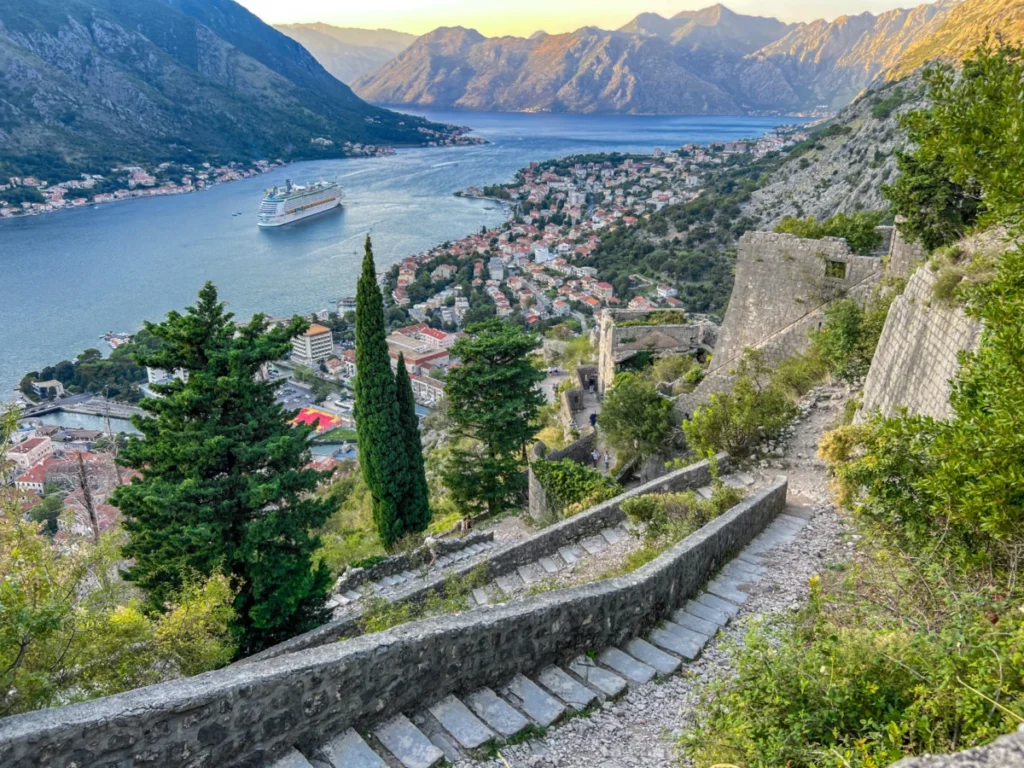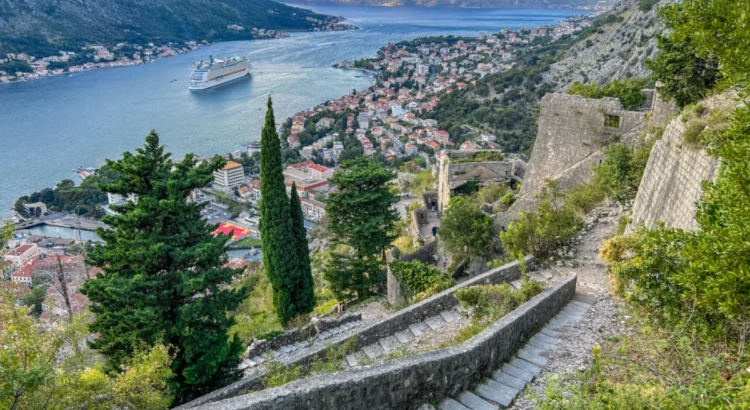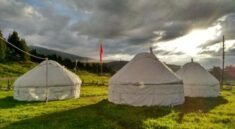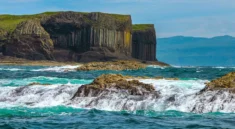
Hidden along the Adriatic coast of Montenegro lies a journey both ancient and elevating—not just physically, but spiritually and visually. The Ladder of Kotor, or “Kotor Serpentine”, is an old caravan route etched into the dramatic limestone cliffs behind the fortified town of Kotor, offering those who ascend it one of the most breathtaking views in the Balkans. Winding up in a series of switchbacks that resemble a stone staircase laid by giants, this trail rewards the determined hiker with panoramas that feel biblical in scale—fjords, fortresses, and forgotten time.
In a town increasingly shaped by cruise ship schedules and seasonal swells, this hike offers something vanishingly rare: solitude, stillness, and unfiltered perspective. You rise above the noise—both literal and metaphorical—and enter a space shaped by centuries of pilgrims, shepherds, and merchants, but barely touched by modern tourism. The Ladder of Kotor is not just a trail; it’s a journey into Montenegro’s soul.
Kotor: A Medieval Marvel By The Sea
To understand the magic of the trail, you must begin in Kotor, a UNESCO World Heritage town cradled within a fjord-like bay. Though technically a ria (a submerged river valley), the Bay of Kotor has the dramatic, narrow charm of a Norwegian fjord, hemmed in by towering cliffs and dotted with tiny islands and walled settlements.
Kotor itself is a treasure trove of Venetian architecture, cobblestone alleys, and history-soaked cathedrals. Its thick stone walls once defended against Ottoman raiders and sea invaders; today, they fend off the influx of tourists disembarking from luxury liners. While the old town is undeniably beautiful, it can be stifling in summer—crowded, commercialized, and sometimes claustrophobic.
That’s why the Ladder of Kotor is such a revelation. Just beyond the bustle, this historic trail offers elevation and escape, allowing you to look down on the town, the bay, and the past—with new eyes.
The Origins Of The Trail: A Road Worn By Time
The Ladder of Kotor, also known locally as the Vrmac Pass, is part of an old trade and military route that once connected Kotor to the highland village of Njeguši, and further on to Cetinje, the historic capital of Montenegro. Before tunnels and asphalt roads, this path was the only way in and out of Kotor from the mountains above.
Built with dry-stacked stone and centuries of labor, the trail zigzags up the mountain in nearly 70 switchbacks. Its construction was a marvel of engineering for its time, designed to be navigable by horses, donkeys, and people laden with goods.
While roads and highways have rendered the trail obsolete for commerce, it lives on for adventurers seeking a taste of the old Montenegro—a land of fierce independence, layered history, and poetic landscapes.
The Hike Itself: From Sea To Sky
The trail begins just outside Kotor’s city walls, behind the Church of Our Lady of Remedy, and quickly begins to climb. Don’t be fooled by the gentle start: the elevation gain is substantial—around 940 meters (3,000 feet) over 5 to 6 kilometers. But unlike more rugged mountain ascents, the path is relatively even and meticulously laid, making it a challenge of endurance more than danger.
The switchbacks are tight and rhythmic. With each turn, the view expands, as if you’re peeling back layers of the earth’s own canvas:
- At first, you see Kotor’s rooftops, orange and tight.
- Then, the church bell towers and stone walls reveal their geometry.
- Higher still, the entire Bay of Kotor opens like a storybook, with islands, inlets, and peaks reflected in glacial blue waters.
You’ll encounter goats, birds of prey, and wild herbs like thyme and oregano underfoot. If you start early, you may walk for hours without seeing another human being. The sound of your footsteps on ancient stones, the wind whispering through olive branches, and the distant clang of a church bell become your soundtrack.
Highlights Along The Way
1. San Giovanni Fortress (Optional Detour)
Before beginning the Ladder proper, some hikers choose to ascend through Kotor’s fortress walls to San Giovanni Castle, a medieval bastion perched above the town. From here, you can merge onto the Ladder trail via a hidden exit in the upper wall. This route includes an admission fee but provides stunning fortress views and an atmospheric start.
2. Abandoned Shepherd’s Huts and Military Ruins
As you rise, the trail leads past old shepherd shelters, stone huts, and remnants of Austro-Hungarian outposts, some covered in ivy, others open to the sky. They offer shady spots to rest, picnic, and imagine life when this trail was lifeblood rather than leisure.
3. Panoramic Bench Points
Several natural terraces serve as unofficial lookout points. At the 45th switchback, hikers often stop to breathe, snack, and take in a God’s-eye view of the Bay of Kotor—its serpentine curves, mirrored water, and towns like Perast and Tivat in the distance.
Arriving At The Plateau: Njeguši And Beyond
At the top, the trail spills into alpine meadows and pine forests, where the temperature drops and the air feels crisp and clean. From here, you can either:
- Turn back the way you came, enjoying a new perspective on the descent.
- Continue onward to Njeguši, the village famed for its Njeguški pršut (dry-cured ham) and cheese, both delicacies in Montenegro.
- Or, for the intrepid, link up with multi-day treks into Lovćen National Park, home to the mausoleum of Petar II Petrović-Njegoš, Montenegro’s national poet and ruler.
Whichever option you choose, the climb transforms you. You began in a medieval port. You end in a mountain village where time is measured by wood smoke, cheese aging, and the hum of bees.
Avoiding The Crowds: Timing And Strategy
Kotor has become a cruise ship hotspot, with peak months (June to September) bringing thousands of day-trippers. To enjoy the Ladder of Kotor in peace:
- Start early (before 8:00 AM), both for cool temperatures and solitude.
- Consider hiking in shoulder seasons (April–May or September–October) when the weather is mild and the landscape green.
- Pack water, snacks, sun protection, and wear proper hiking shoes. The trail is exposed and can get hot by mid-day.
- Download an offline map—signage is minimal but the path is straightforward.
More Than A Hike: A Reflection
What makes the Ladder of Kotor so special isn’t just the views—though they’re spectacular. It’s the sense of continuity. You walk a trail built by hands long gone, stepping where soldiers, smugglers, traders, and monks once passed. The stones beneath your feet have felt the burden of history and the passage of generations.
And as you rise above the buzz of modern life, you gain perspective—not just geographically, but emotionally. The town shrinks. The mountains expand. So does your spirit.
This is slow travel, grounded travel, meaningful travel. No Instagram filter can capture the scent of pine warmed by the sun, or the feeling of wind against your face as you stand 900 meters above a glittering bay.
Closing Thoughts: Montenegro’s Ladder To The Sky
In a world where over-tourism dulls the edges of even the most beautiful places, the Ladder of Kotor remains sharp, soulful, and rewarding. It doesn’t promise comfort or convenience. But for those willing to lace up their boots and put one foot in front of the other, it offers something far more enduring: a memory that belongs to you alone.
So skip the line at the gelato stand. Wake early. Walk up. Breathe in the sky. Stand on ancient stones and look down not just on Kotor, but on a thousand years of resilience, beauty, and movement.
Because in climbing the Ladder of Kotor, you don’t just leave the crowds behind—you climb into history, into self, into silence.



